 |
|||||||||||||||||||||||||||||||||||||||||||
|
“I think
I shall postpone January.” |
|||||||||||||||||||||||||||||||||||||||||||
|
Valentine’s Day isn’t far away so I expect to see reds, whites, and pinks featured in the botanical garden’s indoor flower displays. Usually begonias and cyclamen fill the bill. This year though there was a newcomer. Planted under three sizable planters of oleander trees in the reception hall were dozens of strawberry-pink, double-flowered kalanchoes. 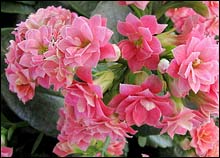 The kalanchoes were labelled ‘Calandiva Pink.’ I checked the web and found that I had stumbled upon a new superstar. The Calandivas were developed in 2002 by a Swedish breeder and are now being propogated, distributed, and marketed by Fides, a Dutch firm that specializes in growing and promoting high-end flowers with unusual shapes and colors. The kalanchoes were labelled ‘Calandiva Pink.’ I checked the web and found that I had stumbled upon a new superstar. The Calandivas were developed in 2002 by a Swedish breeder and are now being propogated, distributed, and marketed by Fides, a Dutch firm that specializes in growing and promoting high-end flowers with unusual shapes and colors.Fides has even developed a website just to promote Calandiva Kalanchoes. On its homepage, the plants are hyped as rock-stars or supermodels: “Calandiva® appeals to many around the world. With this diva’s broad array of applications, she transcends many cultures and habits. From Tokyo to Milan, stylists, designers and florists have her starring on their catwalks.” When the Calandiva line was launched a few years ago, Fides developed promotional packets to flood the florists, garden centers, and big-box stores in eight European countries. They even had a sweepstakes offering a luxury weekend in the Netherlands as part of the blitz. I don’t know how common Calandiva Kalanchoes are in the U.S., but tomorrow I plan to go to Lowe’s and then to a large greenhouse nursery to see if I can find them there. 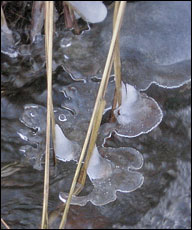 Dry stocks of grasses have fallen into the water at the edge of a stream that feeds the lake in the Japanese Garden. The eddies in the current coupled with the cold temperatures formed these ice flowers on the ends of the brown stems. Dry stocks of grasses have fallen into the water at the edge of a stream that feeds the lake in the Japanese Garden. The eddies in the current coupled with the cold temperatures formed these ice flowers on the ends of the brown stems.I read a newspaper article last week about the new plants that are being shown this year at nursery trade shows. These shows aren’t open to the public, but the plants and flowers featured there are likely to appear in retail stores very soon. The article mentioned the growing popularity of camellias such as Pink Icicle and Winter Snowman that can withstand sub-zero temperatures. That I knew. Hardy camellias are becoming common here in this Zone 6 botanical garden. 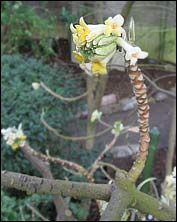 But it also mentioned the paper bush (Edgeworthia papyrifera) – a plant that I would never have thought of as being able to survive the cold. For years I’ve made it a point to take in the sweet smell of the paper bush flowers that open at this time in the glasshouse that shelters the Mediterranean climate plants. But I never thought it could survive outside. Apparently neither dio the keepers of this botanical garden. I checked their database of plantings and found that the only specimen of this awkward-looking shrub in the botanical garden is the one growing here under glass. Flora, the all-knowing encyclopedia of plants, says that paper bush shrubs are “moderately frost hardy, but are likely to be severely damaged if struck by a late frost after the young foliage has started to develop.” I wonder if this botanical garden will set-out an outdoor plant or two this summer. Image the exotic scent of paper bush flowers on a cold winter’s day. But it also mentioned the paper bush (Edgeworthia papyrifera) – a plant that I would never have thought of as being able to survive the cold. For years I’ve made it a point to take in the sweet smell of the paper bush flowers that open at this time in the glasshouse that shelters the Mediterranean climate plants. But I never thought it could survive outside. Apparently neither dio the keepers of this botanical garden. I checked their database of plantings and found that the only specimen of this awkward-looking shrub in the botanical garden is the one growing here under glass. Flora, the all-knowing encyclopedia of plants, says that paper bush shrubs are “moderately frost hardy, but are likely to be severely damaged if struck by a late frost after the young foliage has started to develop.” I wonder if this botanical garden will set-out an outdoor plant or two this summer. Image the exotic scent of paper bush flowers on a cold winter’s day.When temperatures fall to nearly zero, I know that frost feathers will appear on the single-paned windows in the Linnaean House, the Victorian glasshouse that shelters the camellias. Since temperatures don’t get this low very often, I try not to miss the show. On bright mornings like this one, I know I have to get to the glasshouse early before the sun gets too high and melts the ice tracings.  The tracings on glasshouse windows with a southern exposure had already melted when I arrived shortly after eight. The ones on the northeast side though still were frozen into ice formations that mimic the leaves of bear’s breeches (Acanthus mollis). It’s an apt design for a glasshouse that was built about the time Arts and Crafts artists began incorporating acanthus leaves into their work. 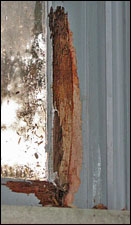 While looking at the ice designs, I noticed that the lower sash and the window stop of a newly installed wooden window had been gnawed away. There’s enough wood gone to see daylight through the stop. I know that on warm winter days the keepers of the camellia house open the doors to save on artificial heat and to let breezes and birds through. However when the doors are closed, sometimes a bird or two is trapped inside. The damage I saw today wasn’t done by a bird though. I’m betting a squirrel get shut up. Judging from the progress made so far, the creature is close to breaking out. I think I know why too. From a website on squirrels: “Squirrels are the most active in late winter, when the mating season begins. The males will chase a female . . . through the trees at top speed . . . perform[ing] some of the most breathtaking acrobatics imaginable.” Some inside squirrel can't wait to join the action outside. While looking at the ice designs, I noticed that the lower sash and the window stop of a newly installed wooden window had been gnawed away. There’s enough wood gone to see daylight through the stop. I know that on warm winter days the keepers of the camellia house open the doors to save on artificial heat and to let breezes and birds through. However when the doors are closed, sometimes a bird or two is trapped inside. The damage I saw today wasn’t done by a bird though. I’m betting a squirrel get shut up. Judging from the progress made so far, the creature is close to breaking out. I think I know why too. From a website on squirrels: “Squirrels are the most active in late winter, when the mating season begins. The males will chase a female . . . through the trees at top speed . . . perform[ing] some of the most breathtaking acrobatics imaginable.” Some inside squirrel can't wait to join the action outside.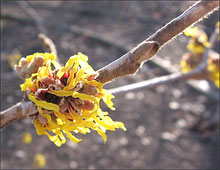 The leaves on the rhododendrons are curled up. The pansies are limp and playing dead. I returned to the Chinese witch hazel that last week looked so spectacular in bloom to see how it was dealing with the cold. The petals on the blooms look like supple tentacles all moving in whatever direction the wind blew them. The leaves on the rhododendrons are curled up. The pansies are limp and playing dead. I returned to the Chinese witch hazel that last week looked so spectacular in bloom to see how it was dealing with the cold. The petals on the blooms look like supple tentacles all moving in whatever direction the wind blew them.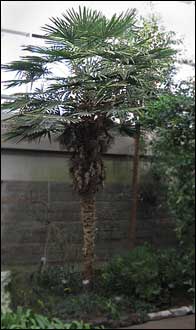 I checked briefly on the three palms growing outside. They all seem to be ignoring the cold temperatures. But for all I know about palms, they might be dead and are still staying green until the weather warms. Of the three hardy varieties (Dwarf Palmetto, Windmill, and Needle), I’m most interested in the Windmill Palm because it’s destined to become a tree. A tree with a trunk and a mop of leaves on top -- a real palm tree, not a clump of unruly twigs. I figured this botanical garden had to have a mature Windmill Palm somewhere so I moved inside the glasshouses to try to find one. There weren’t any in the tropical glasshouse, so I check the house with the Mediterranean plants. How could I have missed it? I’ve visited this house hundreds of times, seeing it, but not knowing I was seeing it. It's the tallest palm in the house – a mature Windmill Palm about ten or twelve feet tall. I checked briefly on the three palms growing outside. They all seem to be ignoring the cold temperatures. But for all I know about palms, they might be dead and are still staying green until the weather warms. Of the three hardy varieties (Dwarf Palmetto, Windmill, and Needle), I’m most interested in the Windmill Palm because it’s destined to become a tree. A tree with a trunk and a mop of leaves on top -- a real palm tree, not a clump of unruly twigs. I figured this botanical garden had to have a mature Windmill Palm somewhere so I moved inside the glasshouses to try to find one. There weren’t any in the tropical glasshouse, so I check the house with the Mediterranean plants. How could I have missed it? I’ve visited this house hundreds of times, seeing it, but not knowing I was seeing it. It's the tallest palm in the house – a mature Windmill Palm about ten or twelve feet tall.There are plenty of palms of all kinds at this botanical garden. But they’re growing under controlled conditions in glass houses. Since I walk mostly outdoors, I don’t look for nor expect to see palms in this Zone 6 garden. A couple weeks ago though I saw three of them growing side by side in the small children’s garden. “It is a myth that palms are exclusively tropical or subtropical species,” so says David Franco, author of Palms Won’t Grow Here and Other Myths. He says that perhaps a hundred of the 1500 known species of palms can handle temperatures of 20ºF. Some, he says, can even get through winters of 0ºF or lower. Most of the palms that Franco writes about aren’t the tree varieties that I think of when I image palms. The hardy varieties he describes are mostly “clump palms” -- palms that grow like shrubs and have no trunks to speak of. 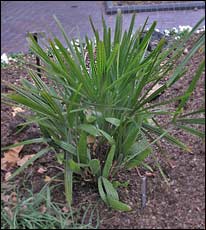 Franco’s book says that one of palms I saw, the Needle Palm (Rhapidophyllum hystrix) “wins the prize as the world’s most cold-hardy palm, at least in climates with warm to hot summers.” That’s us in the Midwest. He says that once established, a Needle Palm could get through winter temperatures of -10º or even maybe -20ºF. The shrub I saw was about three-feet tall and looked green and healthy even without being mulched. It has so few leaves that’s it hard to see the palm’s characteristic splayed fingers-shaped leaves. If this Needle Palm matures, it will expand into a large circular clump and will be about eight-feet tall. Here’s a picture of a mature specimen growing in the National Arboretum in Washington, D. C. Franco’s book says that one of palms I saw, the Needle Palm (Rhapidophyllum hystrix) “wins the prize as the world’s most cold-hardy palm, at least in climates with warm to hot summers.” That’s us in the Midwest. He says that once established, a Needle Palm could get through winter temperatures of -10º or even maybe -20ºF. The shrub I saw was about three-feet tall and looked green and healthy even without being mulched. It has so few leaves that’s it hard to see the palm’s characteristic splayed fingers-shaped leaves. If this Needle Palm matures, it will expand into a large circular clump and will be about eight-feet tall. Here’s a picture of a mature specimen growing in the National Arboretum in Washington, D. C.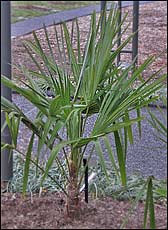 Along with Needle Palm there’s a Dwarf Palmetto (Sabal minor) and a Chinese Windmill Palm (Trachycarpus fortunei) here. Both are still quite small. The Dwarf Palmetto is another clumping variety, but the Windmill Palm is a true palm tree with a slender trunk and an umbrella of leaves on top. The Windmill in this botanical garden already has the beginnings of a trunk. Here's a picture of what a mature Windmill Palm would look like. Along with Needle Palm there’s a Dwarf Palmetto (Sabal minor) and a Chinese Windmill Palm (Trachycarpus fortunei) here. Both are still quite small. The Dwarf Palmetto is another clumping variety, but the Windmill Palm is a true palm tree with a slender trunk and an umbrella of leaves on top. The Windmill in this botanical garden already has the beginnings of a trunk. Here's a picture of what a mature Windmill Palm would look like.Why this fascination with things rightfully tropical? Two reasons, David Franco thinks. First, it’s “something elemental in the human psyche.” There’s a longing for green, for lushness, for warmth in each of us. We want to get back to Eden where nature is more generous. Second, the challenge and pride that comes with it of being able to do the unexpected. A palm grower in Philadelphia who has a web site about growing palms in unexpected places puts it this way, “I want to have a palm growing in my garden, not because it will make the winters feel any warmer, but because it provides a link to that warmer world. I'd like to look at those shots of palms on TV and think, "Sure, I've got one of those!" 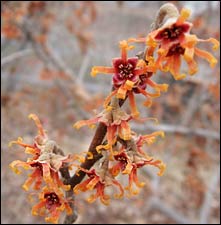 A friend gave me a calendar of natural events that was published by the state conservation department. Every day there’s a seasonal tidbit about some plant or animal. Today the calendar tells me to “Look for signs of wildlife feeding on saplings: deer, a ragged cut; rabbits a neat 45º slice.” Looking ahead to next week, it says “Ozark witch hazel begins blooming after a few days of warm weather.” So I took a look at the Ozark witch hazels planted in this botanical garden to see how they were getting on. Many of the Ozarks planted in the native plants section of the garden were already in bloom. While the one in the picture I took had burnt-orange blooms, I’ve read that others have yellow or even more reddish flowers than the one I saw. Ozark witch hazel (Hamamelis vernalis) blooms may not be as large as some, but they are plentiful and I know they will last for months. A friend gave me a calendar of natural events that was published by the state conservation department. Every day there’s a seasonal tidbit about some plant or animal. Today the calendar tells me to “Look for signs of wildlife feeding on saplings: deer, a ragged cut; rabbits a neat 45º slice.” Looking ahead to next week, it says “Ozark witch hazel begins blooming after a few days of warm weather.” So I took a look at the Ozark witch hazels planted in this botanical garden to see how they were getting on. Many of the Ozarks planted in the native plants section of the garden were already in bloom. While the one in the picture I took had burnt-orange blooms, I’ve read that others have yellow or even more reddish flowers than the one I saw. Ozark witch hazel (Hamamelis vernalis) blooms may not be as large as some, but they are plentiful and I know they will last for months. In another part of the garden, another species of witch hazel was in bloom. This one, the Chinese Witch Hazel (Hamamelis mollis) has pure yellow flowers with petals that are twice as wide and long as the Ozark. The close-ups here are not nearly as arresting as seeing (and smelling) a cluster of these tall shrubs all in bloom. In another part of the garden, another species of witch hazel was in bloom. This one, the Chinese Witch Hazel (Hamamelis mollis) has pure yellow flowers with petals that are twice as wide and long as the Ozark. The close-ups here are not nearly as arresting as seeing (and smelling) a cluster of these tall shrubs all in bloom.Just before Christmas we happened to see the chef of the restaurant at this botanical garden. He said that the week before Christmas and the week between Christmas and New Year’s were among the busiest of the year for the restaurant and for the botanical garden. After the first of the year, it’s a “dead zone,” he told us. I think he’s right. As we walked we saw only the morning regulars and a few newcomers who were walking with purpose, as though fulfilling a newly made resolution. 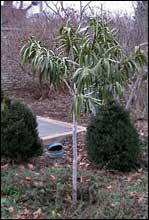 The ‘Double White’ Oleander trees that are wintering over in the Ottoman Garden seem none the worse for staying out in the single digit nights of last week. They have all of their leaves and they’re still a summery shade of green. The leaves now point down instead of out, but they show no signs of giving up. Let’s say they make it through the winter just as they look now. The next hurtle will be to bloom again in the summer. The ‘Double White’ Oleander trees that are wintering over in the Ottoman Garden seem none the worse for staying out in the single digit nights of last week. They have all of their leaves and they’re still a summery shade of green. The leaves now point down instead of out, but they show no signs of giving up. Let’s say they make it through the winter just as they look now. The next hurtle will be to bloom again in the summer.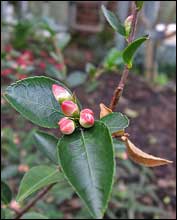 I've been watching a small camellia shrub named Camellia transnokoensis since mid-November. I noticed it then because it was loaded with pink buds that looked ready to pop. It's a week into the new year and the shrub still looks just as expectant. Nothing’s happened. It’s stayed on the verge of blooming for nearly two months. Do botanists ever track bud to bloom time? Growers of floral plants certainly must. Of course, sheltered as this Camellia transnokoensis is here in a heated glasshouse, it can poke along if it wants to. Outside though, in its native haunt on the high slopes of Mt. Noko in central Taiwan, I bet it moves right along. I've been watching a small camellia shrub named Camellia transnokoensis since mid-November. I noticed it then because it was loaded with pink buds that looked ready to pop. It's a week into the new year and the shrub still looks just as expectant. Nothing’s happened. It’s stayed on the verge of blooming for nearly two months. Do botanists ever track bud to bloom time? Growers of floral plants certainly must. Of course, sheltered as this Camellia transnokoensis is here in a heated glasshouse, it can poke along if it wants to. Outside though, in its native haunt on the high slopes of Mt. Noko in central Taiwan, I bet it moves right along. Massive panes of ice left behind by warmer weather filled the base of one of the garden’s reflective ponds. The plate glass slabs, some four inches think, made the pond look like an accident scene. 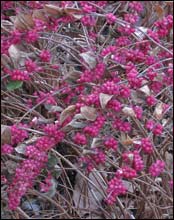 Winter’s just begun, but the birds and the squirrels have stripped most of the berries from the beautyberries, winterberries, viburnum shrubs and holly trees. Untouched though is the colony of coralberry shrubs (Symphoricarpos orbiculatus) bordering the bird garden. Their drooping branches are still laced with fat clusters of purple berries. Most internet sites that mention the coralberry (including the plant finder database of this botanical garden) say that birds like to eat the berries. One dissenter is a site written by a county extension agent from Washington State. She says, “S. orbiculatus is noted in many sources as attractive to birds but if so, why do those berries hang on all winter?” She thinks maybe it’s because the berries are full of saponin, a natural detergent that could give the birds digestive problems. Winter’s just begun, but the birds and the squirrels have stripped most of the berries from the beautyberries, winterberries, viburnum shrubs and holly trees. Untouched though is the colony of coralberry shrubs (Symphoricarpos orbiculatus) bordering the bird garden. Their drooping branches are still laced with fat clusters of purple berries. Most internet sites that mention the coralberry (including the plant finder database of this botanical garden) say that birds like to eat the berries. One dissenter is a site written by a county extension agent from Washington State. She says, “S. orbiculatus is noted in many sources as attractive to birds but if so, why do those berries hang on all winter?” She thinks maybe it’s because the berries are full of saponin, a natural detergent that could give the birds digestive problems.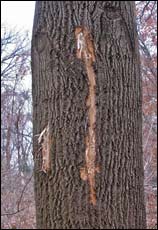 Problems of another kind: The bark of a huge tulip tree at the north end of the English Woodland Garden has long gashes on all sides of its trunk from about four feet from the ground to the side branches near its top. The gashes are long. I’d guess some of the ones near the top of the tree are four-feet long. They look as though a mechanical something nicked the tree as it was edging by. But there is no evidence of nearby disturbance or damage. Animals? I don’t think so. The gashes go too far up the tree and are too deep and wide. The only thing that I could find to explain them is a phenomenon called “frost cracking.” It’s caused when rapid drops of temperatures cause the barks of certain trees to contract unevenly and then crack. But from the pictures of frost cracking that I saw on Google, the damage didn’t look as nearly distressing to the tree as gashes on this tulip tree. Problems of another kind: The bark of a huge tulip tree at the north end of the English Woodland Garden has long gashes on all sides of its trunk from about four feet from the ground to the side branches near its top. The gashes are long. I’d guess some of the ones near the top of the tree are four-feet long. They look as though a mechanical something nicked the tree as it was edging by. But there is no evidence of nearby disturbance or damage. Animals? I don’t think so. The gashes go too far up the tree and are too deep and wide. The only thing that I could find to explain them is a phenomenon called “frost cracking.” It’s caused when rapid drops of temperatures cause the barks of certain trees to contract unevenly and then crack. But from the pictures of frost cracking that I saw on Google, the damage didn’t look as nearly distressing to the tree as gashes on this tulip tree. I’m always on the lookout for things visitors do to personalize this botanical garden without damaging or littering it. This morning I saw this lost pink glove that someone had put on the hand of iron cutout of a pioneer child near the entrance to the Children’s Garden. Also a few weeks ago, I saw a long stem red rose that likely was left behind from someone’s family celebration. It was left outdoors and carefully positioned on a wrought iron Victorian-style bench. I’m always on the lookout for things visitors do to personalize this botanical garden without damaging or littering it. This morning I saw this lost pink glove that someone had put on the hand of iron cutout of a pioneer child near the entrance to the Children’s Garden. Also a few weeks ago, I saw a long stem red rose that likely was left behind from someone’s family celebration. It was left outdoors and carefully positioned on a wrought iron Victorian-style bench. |
||||||||||||||||||||||||||||||||||||||||||